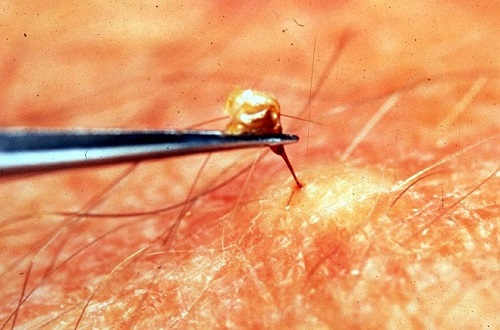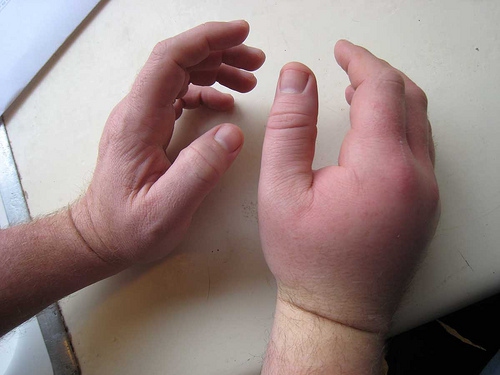Stings from busy honeybees are among the most common in the United States today. Honeybees are most likely to sting an individual when they feel provoked or threatened. Unfortunately, due to their small size, a person may "threaten" them by simply walking by. Although honeybee stings are rarely fatal, their stingers do contain toxins which cause itching, irritation, and swelling.
How to Remove a Bee Stinger
The age-old approach of using tweezers to pluck it out is not as effective as many people think. As you poke and prod the stinger in an attempt to remove it, more venom will be released leading to more irritation of the area. Instead of reaching for tweezers, try these methods:
Scrape with a penny. Reach into your pocket and pull out a penny – or any coin – and slowly press it along the swelled area. You can gently scrape the skin to push out the stinger.
Scrape with an onion. The juice of the onion can actually counteract the toxins from the stinger. Slice a large chunk of onion and gently scrap it across the skin where you have been stung. This may take a few strokes, but it should catch the stinger and pull it out.
Scrape with a butter knife. If you happen to be home when stung, grab a butter knife. Use the flat, dull edge of the knife with short brush strokes along the skin. The goal is to push out the stinger from the bottom by applying steady pressure with the knife.
Scrape with a credit card. A sturdy credit card can also do the trick. Place it at an angle towards the stinger and slide across the skin. The edge of the card has the ability to force the stinger out.
Catch with a nail file. The material of a nail file can catch the stinger and pull it out. To use this method, simply make short strokes across the skin with the course side of the file.
Use a sterile needle. Another old approach for how to remove a bee stinger is with a sterile needle. This process is a bit more invasive and best when the stinger is deep inside the skin. Sterilize a small sewing needle in boiling water. Use the tip to slowly pick back the layers of the skin around the stinger to reveal the tip. You can then use the needle or tweezers to pull the stinger out.
Tape. An ideal method for children. Simply place a small piece of tape over the area and remove it with a gentle pull forward. Medical tape is the best option for this as it will not stick to the skin as easily and also has the mesh material to effectively catch the stinger.
Wax. Hair removal wax can be used to not only calm the inflammation of the area, but also extract a bee stinger. Apply a small amount with a toothpick or popsicle stick. Allow it to harden then peel off with hair removal paper or cloth, as you would normally.
Fingernail. In an emergency situation, you can use your fingernail to push out a stinger. Carefully stroke the skin with the tip of your nail until the stinger pops out. However, keep in mind, that fingernails contain countless amounts of bacteria. This option should only be used when there are no other options.
Ice cube. Applying an ice cube to the area will first soothe the skin and second harden the skin and the stinger. You can then use any other method to push the stinger out.
How to Treat a Bee Sting
Now you've succeeded with all the methods of how to remove a bee stinger, you should also know the proper ways of treating the skin after the stinger is removed. Here are seven solutions for treating the swelling, itching, and discomfort that come from bee stings.
Toothpaste. Apply a small amount of toothpaste to the area to cool the burning sensation from the sting.
Vinegar + baking soda + meat tenderizer. The active enzyme in meat tenderizer is papain. This breaks down bee venom toxins. Combined with baking soda and vinegar, it turns into a foaming solution which will soothe the area. Apply and wait 20 minutes to see if symptoms retreat.
Honey. Honey has natural antibacterial properties. Apply a small amount to the area for approximately 30 minutes. It should cool the irritation.
Raw onion. Raw onion is used for many holistic remedies because it has the ability to absorb and pull toxins from the skin. Slice a chunk and apply it directly to the area to absorb bee venom. Keep mind, however, that the onion juice may irritate the skin in other ways.
Raw potato. Slice open a raw potato and apply it face down over the stung area. The enzymes will provide temporary relief.
Antihistamines. Antihistamine creams can be directly applied to the stung area for better results than pills. This may relieve symptoms for up to 30 minutes.
Watch Out for Allergic Reaction
With all the knowledge of how to remove a bee stinger, it is still important to watch out for allergic reaction. Allergic reactions can vary from person to person and the reaction can be different each time you are stung. There are three levels of reaction to watch out for:
Mild reaction: Symptoms include red welt at area where stung, white spot at stinger injection site, slight swelling, and instant burning of the area.
Moderate reaction: Extreme redness, heat, and swelling. A moderate reaction may worsen over the 48-hours after being stung. It should resolve itself within 10 days.
Severe reaction: Rapid pulse, vomiting or diarrhea, difficulty breathing, hives, or swelling of the tongue and throat.
Anytime you experience a severe reaction, consult a doctor. If immediate anaphylaxis starts, call 911 or get to your local emergency service provider. Some people are unaware of a severe allergy until their first dramatic experience. If you feel that your condition is worsening, contact an allergist for testing and solutions. Any person who has had multiple stings should also seek medical attention. One sting alone is not likely to be fatal to most people, however multiple is.





View All Comments /Add Comment